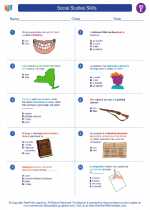Social Studies Skills -> types of maps
Types of Maps
Maps are important tools that help us understand and navigate the world around us. There are several different types of maps, each serving a specific purpose and providing different kinds of information.
1. Political Maps
Political maps show the boundaries of countries, states, and cities. They are used to illustrate the political divisions of a specific area and often include labels to identify the names of the regions and their boundaries.
2. Physical Maps
Physical maps depict the natural features of an area, such as mountains, rivers, and bodies of water. They use colors and shading to represent different elevations and landforms, providing a visual representation of the physical geography of a region.
3. Topographic Maps
Topographic maps are similar to physical maps but include additional details such as contour lines to show the elevation and shape of the land's surface. These maps are commonly used by hikers, geologists, and urban planners to understand the terrain and plan routes.
4. Climate Maps
Climate maps illustrate the climate zones and weather patterns of a specific area. They use color coding to represent different climate regions, such as tropical, arid, temperate, and polar, providing valuable information for agricultural and environmental planning.
5. Road Maps
Road maps are designed to help travelers navigate roadways and highways. They include detailed information about roads, highways, and transportation routes, along with symbols and legends to indicate landmarks, gas stations, and rest areas.
6. Population Maps
Population maps show the distribution and density of human populations in a specific area. They use colors or symbols to represent the concentration of people, helping governments and organizations plan for infrastructure, housing, and services.
7. Historical Maps
Historical maps depict the geographical boundaries and features of an area at different points in history. They are valuable resources for understanding how territories, cities, and landscapes have changed over time.
Understanding the different types of maps can provide valuable insights into the varied aspects of our world, from political divisions to natural landscapes and historical developments.
Study Guide:- What is the purpose of a political map?
- How do physical maps represent the natural features of an area?
- What additional details do topographic maps include?
- What information do climate maps provide?
- Who would use a road map?
- How do population maps represent human populations?
- Why are historical maps valuable?
◂Social Studies Worksheets and Study Guides Fifth Grade. Social Studies Skills

 Worksheet/Answer key
Worksheet/Answer key
 Worksheet/Answer key
Worksheet/Answer key
 Worksheet/Answer key
Worksheet/Answer key
 Worksheet/Answer key
Worksheet/Answer key
 Worksheet/Answer key
Worksheet/Answer key
 Worksheet/Answer key
Worksheet/Answer key
